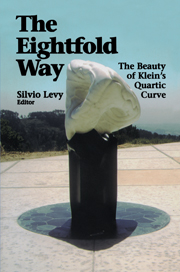Book contents
- Frontmatter
- Contents
- Preface: MSRI and the Klein Quartic
- The Eightfold Way: A Mathematical Sculpture by Helaman Ferguson
- The Geometry of Klein's Riemann Surface
- The Klein Quartic in Number Theory
- Hurwitz Groups and Surfaces
- From the History of a Simple Group
- Eightfold Way: The Sculpture
- Invariants of SL2(𝔽q) . Aut(𝔽q) Acting on ℂn for q = 2n ± 1
- Hirzebruch's Curves F1 , F2 , F4 , F14 , F28 for Q(V7)
- On the Order-Seven Transformation of Elliptic Functions
From the History of a Simple Group
Published online by Cambridge University Press: 25 June 2025
- Frontmatter
- Contents
- Preface: MSRI and the Klein Quartic
- The Eightfold Way: A Mathematical Sculpture by Helaman Ferguson
- The Geometry of Klein's Riemann Surface
- The Klein Quartic in Number Theory
- Hurwitz Groups and Surfaces
- From the History of a Simple Group
- Eightfold Way: The Sculpture
- Invariants of SL2(𝔽q) . Aut(𝔽q) Acting on ℂn for q = 2n ± 1
- Hirzebruch's Curves F1 , F2 , F4 , F14 , F28 for Q(V7)
- On the Order-Seven Transformation of Elliptic Functions
Summary
The attractive pattern of 168 shaded and 168unshaded triangles shown in Figure 1 has aninteresting history. Since its discovery by Kleinin 1878 (see [Klein 1879]), it has often beenreproduced; a close cousin (Figure 2) inspired thebadge of the 1978 International Congress ofMathematicians in Helsinki. This article considersits origins, which lie in the fields of nineteenthcentury geometry and the theory of equations.
In each of the 14 slices emanating from the centerthere are 12 shaded and 12 unshaded triangles, sothere are 168 of each kind. The sides of eachtriangle are arcs of circles orthogonal to theboundary circles, or are diameters. The figure canbe continued in this fashion to reach indefinitelyclose to the boundary, and it provides in this way atessellation of the non-Euclidean plane. Theunshaded tessellation is preserved by non-Euclideanreflection in any side of any triangle (i.e., byinversion) and so has the group of all suchreflections as its symmetry group. The groupgenerated by all products of pairs ofreflections isthe symmetry group of the shaded figure.
Klein had been led to construct the figure because ofits use in studying a certain polynomial equation(described at the end of this paper) for which thegroup permuting the roots is PSL(2; ℤ/7ℤ), sometimesknown as G168 because of the number ofits elements. Our first task, then, is to understandthis group geometrically.
Information
- Type
- Chapter
- Information
- The Eightfold WayThe Beauty of Klein's Quartic Curve, pp. 115 - 132Publisher: Cambridge University PressPrint publication year: 1999
